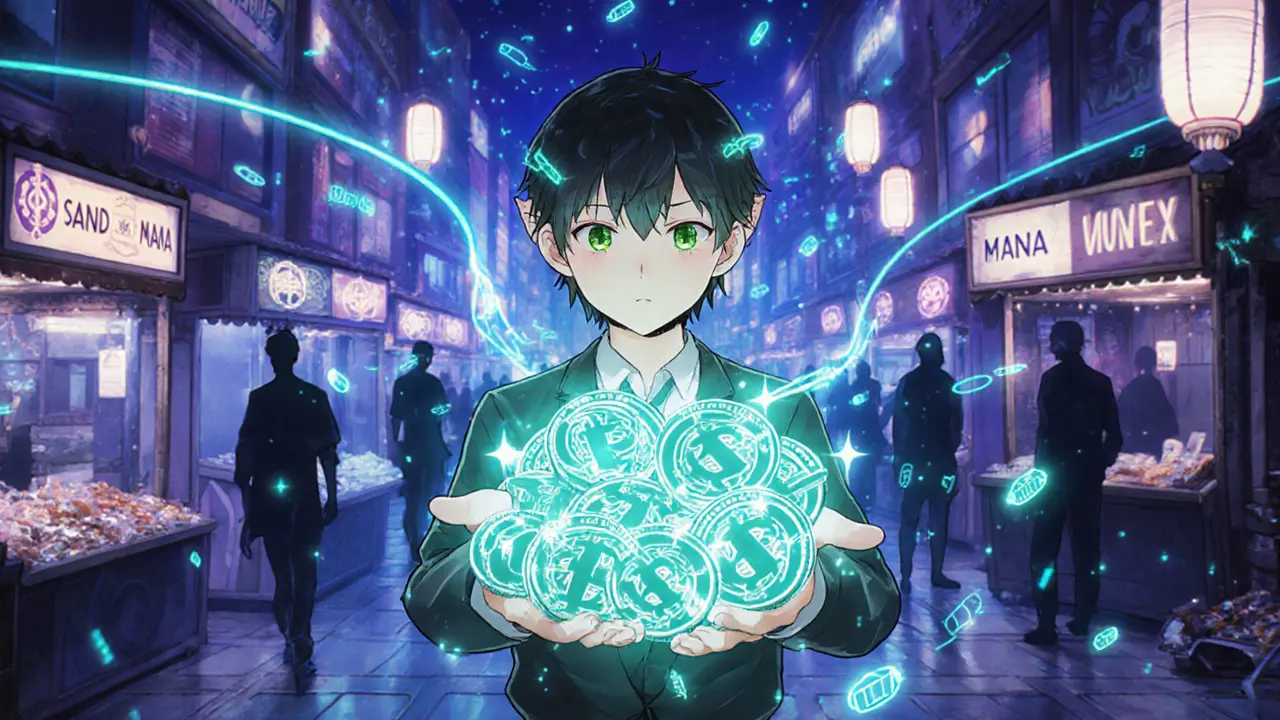THE LAND ELF Crossing (ELF) Coin Explained: Token, Game, and Market Overview

ELF Liquidity Impact Calculator
Calculate Your Trade Impact
The ELF token has extremely low liquidity. This tool demonstrates how trade size impacts price due to limited market depth.
Current Market Data
Your Trade Impact
ELF has very low liquidity (24h volume under $10K). Even small trades can cause significant price movement due to limited market depth.
Comparison With Major Metaverse Tokens
See how ELF's liquidity compares to established tokens like SAND and MANA.
Key Takeaways
- THE LAND ELF Crossing (ELF) is a Japan‑focused metaverse farming game built on the Palette Chain blockchain.
- The ELF token serves as the governance and in‑game currency, but liquidity is extremely low and supply data are inconsistent.
- Two main NFT types-Master NFTs (avatars) and LAND NFTs (virtual real‑estate)-drive gameplay and limited trading activity.
- Regulatory compliance is a selling point, yet the project struggles with exchange listings, community engagement, and clear roadmaps.
- Compared with established metaverse tokens like SAND and MANA, ELF’s market depth and user base are marginal.
What Is THE LAND ELF Crossing?
When we talk about THE LAND ELF Crossing (ELF), we’re dealing with a blockchain‑based farming metaverse that launched as a major upgrade to the earlier game “ELF Masters - Arena of Light and Darkness.” The project lives inside the Palette Chain ecosystem, a chain that advertises zero network fees and support for off‑chain payments such as credit cards and mobile carrier billing.
The game lets players grow virtual crops, expand farms, and trade NFT‑encoded harvests. City‑building contests, fishing tournaments, and guild battles add a competitive layer that mimics the “play‑to‑earn” model popular in 2023‑2024 metaverse projects.
Tokenomics: The ELF Token Explained
The ELF token is the native governance token for the entire Palette Chain gaming suite. Holders can vote on game updates, receive rewards for in‑game achievements, and access premium features. According to the official whitepaper, the token’s Ethereum contract address is 0x8A13F32e2A556830F3A5e97a96Ae941abfcB1D5c.
Key token metrics (as of October 2024) are:
- Total supply: 1 billion ELF
- Circulating supply: reported anywhere from 0 to 418 million, creating major market‑cap discrepancies.
- Typical price range: $0.004 - $0.006 USD per ELF on the few exchanges that list it.
- 24‑hour trading volume: usually under $10 K, far below the $100 K benchmark for healthy crypto assets.
These numbers highlight a liquidity crunch-buyers struggle to convert ELF into fiat or other crypto without slippage.
Gameplay & NFTs: Master and LAND Tokens
Two NFT families underpin the ecosystem:
- Master NFT: avatar‑style tokens that grant unique abilities or visual customization.
- LAND NFT: parcels of virtual land where players build farms, set up marketplaces, and host events.
Both NFTs are tradable on secondary markets, but the scarcity of interested buyers means most owners cannot readily sell for a profit. The game’s mobile app, available on iOS and Android, features a simple UI for planting, harvesting, and auctioning crops, yet requires linking an external crypto wallet to move ELF tokens.

Technical Foundations: Why Palette Chain?
Palette Chain markets itself as a “zero‑fee” solution, aiming to lower the barrier for casual gamers who are hesitant about gas costs. It also integrates off‑chain payment gateways, allowing users to buy ELF with credit cards or carrier billing-an unusual feature among blockchain games.
From a developer’s standpoint, the chain uses a Proof‑of‑Authority (PoA) consensus, which keeps transaction times under two seconds. However, PoA centralizes block production to a handful of validators, a design choice that can raise questions about decentralization and long‑term security.
Market Data & Price Reality
Pricing data for ELF is all over the place. Coinbase listed ELF at $0.00548 USD with a 24‑hour volume of €19.41 K, while CoinMarketCap showed a price of $0.00406 USD and a $7.73 K volume. Cryptorank.io even reported an implausibly low price of $0.000000000001, likely a data glitch.
These inconsistencies make it hard for investors to gauge true market depth. For context, leading metaverse tokens such as The Sandbox (SAND) or Decentraland (MANA) routinely see 24‑hour volumes in the $100 K-$200 K range, dwarfing ELF’s activity.
Regulatory Angle: Japanese Compliance
The project touts compliance with Japanese Financial Services Agency (FSA) rules, positioning itself as a safe entry point for Japanese users. Cryptorank.io highlighted this advantage, but analysts like Takashi Ohyama from Chainalysis Japan warned that many “compliant” projects lack transparent documentation, which can erode trust.
In practice, the only notable Japanese partnership was a bitFlyer promotion that required participants to hold roughly ¥30,000 (about $200) worth of ELF. The campaign attracted 500 winners but set a high entry barrier that discouraged casual players.

Pros, Cons, and What to Watch
Pros
- Zero on‑chain fees lower cost for in‑game transactions.
- Integration with traditional payment methods expands accessibility.
- Japanese regulatory positioning could attract a niche audience.
Cons
- Extremely low liquidity and inconsistent supply data.
- Small, almost silent community-Discord shows only a handful of active members.
- Lack of major exchange listings limits exposure.
- Roadmap transparency is poor; no major updates since early 2024.
Key signals to monitor:
- Official supply audit-if the project publishes a verified circulating‑supply figure, credibility may improve.
- New exchange listings-especially on Japanese platforms.
- Gameplay updates that introduce token‑to‑fiat bridges, reducing the “untradeable” stigma.
Comparison With Established Metaverse Tokens
| Token | Blockchain | Total Supply | Approx. Price (USD) | 24‑h Volume (USD) | Unique Feature |
|---|---|---|---|---|---|
| ELF | Palette Chain | 1,000,000,000 | ~0.005 | ~8,000 | Zero on‑chain fees, off‑chain payment support |
| SAND | Ethereum (L2) | 1,000,000,000 | ~0.85 | ~150,000 | Large user‑generated content marketplace |
| MANA | Ethereum (L2) | 10,000,000,000 | ~0.55 | ~120,000 | Established virtual land auctions |
Future Outlook
Analysts from BlockJapan suggest that projects with ELF‑like metrics often fade within 18 months if they cannot boost liquidity and demonstrate genuine utility beyond a niche game. The next 12 months are critical:
- If Palette Chain rolls out a reliable fiat‑on‑ramp, ELF could see a modest inflow of Japanese gamers.
- A transparent audit of circulating supply would calm market‑cap confusion and potentially attract institutional curiosity.
- Strategic partnerships with larger metaverse platforms could give ELF a second‑wind, but none are announced yet.
Until one of these moves materializes, the token remains a high‑risk speculative asset with limited real‑world adoption.
Frequently Asked Questions
What is THE LAND ELF Crossing?
It is a blockchain‑based farming metaverse built on Palette Chain, offering gameplay centered on virtual crops, land ownership, and NFT trading.
How can I acquire ELF tokens?
ELF is listed on a few exchanges like bitFlyer and Coinbase. You can also buy it via off‑chain payment options offered by Palette Chain, then transfer it to a compatible wallet.
What are Master NFTs and LAND NFTs?
Master NFTs act as avatar skins with special abilities, while LAND NFTs represent parcels of virtual real‑estate where you can build farms and host in‑game events.
Is ELF compliant with Japanese regulations?
The project claims compliance with the Japanese Financial Services Agency, but independent verification is limited. The claim is more a marketing angle than a legally certified status.
How does ELF’s liquidity compare to other metaverse tokens?
ELF’s 24‑hour trading volume is usually under $10 K, far below the six‑figure volumes seen for SAND or MANA, indicating very thin liquidity and higher price impact for trades.
Jason Zila
January 28, 2025 AT 17:54THE LAND ELF Crossing tries to ride the play‑to‑earn wave, but its tokenomics raise red flags. The circulating supply numbers swing wildly between 0 and 418 million, which makes market‑cap calculations practically meaningless. Liquidity is so thin you’d need to accept massive slippage to dump a modest amount of ELF. The zero‑fee claim sounds good on paper, yet a Proof‑of‑Authority chain concentrates power in a few validators, undermining decentralization. Off‑chain payment options are a novelty, but they don’t solve the core issue of tradability on major exchanges. Existing listings are limited to a handful of niche Japanese platforms, keeping the token out of sight for most global traders. The NFT marketplace suffers the same lack of demand, so owners rarely see any profit from Master or LAND sales. Overall, the project feels more like a marketing experiment than a sustainable ecosystem.
Cecilia Cecilia
January 29, 2025 AT 21:41ELF’s trading volume remains well below industry standards, highlighting its liquidity challenges.
lida norman
January 31, 2025 AT 01:27Wow, diving into the world of ELF feels like stepping onto a stage where the lights are dim and the audience is a single whisper. The game’s premise of farming virtual crops feels charming, yet the reality of swapping those crops for any real value is painfully thin. Every time I check the price, it flutters between $0.004 and $0.006, like a moth hovering over a dim bulb. The supply numbers are a maze, changing from zero to hundreds of millions without a clear audit. Even the NFTs, which should be the crown jewels, barely find a buyer on secondary markets. The zero‑fee promise sounds like a dream, but the PoA consensus means a handful of validators hold the reins. Japanese regulators love the compliance badge, but without transparent paperwork it feels like a badge on a costume. Players are stuck with off‑chain payment options that sound convenient yet rarely translate into in‑game power. The community is a ghost town – Discord shows just a few active voices echoing in the void. In short, this project is a high‑risk spec that feels more like a glittering mirage than a solid frontier :)
Schuyler Whetstone
February 1, 2025 AT 05:14Look, this ELF thing is a total scammy fantasy. They brag about zero fees while hiding the fact that nobody can actually sell their NFTs without taking a loss. The token supply numbers are a mess – they’re just making stuff up to look good. If you thought the game was fun, think again; it’s just a glorified idle clicker with no real community. The Japanese compliance claim? Pure PR fluff, not a real safety net. And those off‑chain payments? Just a gimmick to lure newbies into a dead‑end. Don’t waste your time or money on this weak sauce.
David Moss
February 2, 2025 AT 09:01It’s evident-ELF is part of a larger hidden agenda; the erratic supply data and obscure listings are classic signs of market manipulation!!! The so‑called “compliance” is likely a front to gain trust whilst the real controllers pull strings behind the scenes!!! Investors should stay vigilant, because the volatility isn’t just market‑driven, it’s engineered!!!
Vinoth Raja
February 3, 2025 AT 12:47From a systemic perspective, the Palette Chain’s PoA model introduces a centralization vector that could, in theory, compromise the long‑term game theory equilibrium of ELF’s token economy. By reducing on‑chain transaction costs, you lower the friction barrier for participant entry, yet you simultaneously create a validator oligopoly that may not align with decentralized incentive structures. This duality necessitates a nuanced approach to governance token distribution, potentially leveraging quadratic voting mechanisms to mitigate validator concentration effects.
Kaitlyn Zimmerman
February 4, 2025 AT 16:34For anyone looking to get involved, start by checking the official supply audit once it’s released – that’ll clear up a lot of the confusion. Also, keep an eye on Japanese exchange listings; a new market could boost liquidity significantly. If you’re new to NFTs, focus on mastering the in‑game farming mechanics first, as that’s where the real utility currently lives.
Chris Morano
February 5, 2025 AT 20:21Even with the challenges, there’s a chance for ELF to turn around if the team delivers on their roadmap. The zero‑fee infrastructure could become a strong selling point for casual gamers, especially in markets where transaction costs are a barrier. Stay positive and watch for any partnership announcements – they could be the catalyst needed.
Marina Campenni
February 7, 2025 AT 00:07I understand the concerns many users have voiced about liquidity and community size. It’s important to remember that emerging projects often face these growing pains before they find their footing. Patience combined with careful monitoring of official updates can make a big difference.
Nick O'Connor
February 8, 2025 AT 03:54In summary, ELF presents a mixed bag of innovative features and significant drawbacks; potential investors should weigh both aspects carefully before committing any capital.